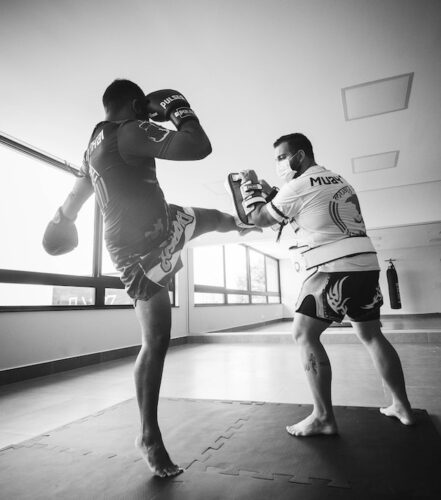Kickboxing is a great exercise for all ages and involves aerobic exercise to help you improve your cardiovascular strength, agility, flexibility, and endurance.
It involves high-intensity workouts that use punches, kicks, and other martial art techniques involving the entire body.
Kickboxing is a great exercise for all ages and involves aerobic exercise to help you improve your cardiovascular strength, agility, flexibility, and endurance.
Personally, I have tried kickboxing as a workout exercise for six months, and I am amazed at the benefits I have seen so far. My mental focus has been sharp, and my mental health has improved drastically.
Also, I have noticed increased cardiovascular endurance, strength, and flexibility. I would recommend kickboxing to anyone looking for a good workout.
In this article, I will discuss why kickboxing is a good workout exercise for anyone to learn and the benefits associated with the sport.
Read: Boxing Vs Kickboxing: Which Is More Effective & Right For You
Table of Contents
Are Kickboxing Workouts Effective?
Kickboxing workouts are effective exercises. They are good for developing your body, strength, balance, and healthy heart. And like other exercises, they are a great way to let off steam or stress.
Studies have shown that kickboxing participants are more likely to lose weight and belly fat than those who do regular exercise. Another study shows that overweight women who participated in the kickboxing program lost more weight and developed abdominal muscle strength than regular exercise participants.
Due to its high-intensity workout, kickboxers can burn up to 450 calories per hour of training — that is, if you are doing it the right way!
The key to kickboxing is its rigorous training and consistency. Enrolling in the 16 weeks or more program is recommended to experience the benefits of kickboxing. Kickboxing is a high-intensity exercise that involves your entire body, thus the best way to burn calories and fat.

Kickboxing workouts are great exercise for all ages – as it improves your stamina, flexibility and strength.
What Are The Benefits Of Kickboxing As An Exercise?
Kickboxing is a mix of cardio and muscle training, which offers vast benefits to its participants. You can expect a more fit physical form, strength, endurance, and more discussed in the list below.
1. Improved Strength and Conditioning
Kickboxing is right for you if you want to improve your strength and physical form. Many kickboxing programs are designed to help you strengthen your legs, upper body, arms, and back all at once. The workout involves moving all your body which is great for burning calories and keeping fit.
2. Increased Cardiovascular Endurance
Kickboxing provides participants with a full-body intensive workout, which is great for increasing cardiovascular endurance and toning the body to shame.
Cardiovascular endurance is the ability of the body to engage in high-intensity activities for a longer period without tiring out. Kickboxing participants will notice an increased energy level when carrying out daily activities.
3. Increased Flexibility
People wrongly perceive kickboxing as a cardio exercise to only increase strength and body toning. However, kickboxing is also great for improving flexibility, especially in hip movements. It involves several stretches, which, when performed over time, will increase flexibility.

Through kicking practise and stretches, you will become more flexible with kickboxing.
4. Better Balance and Coordination
Kickboxing can improve your balance and coordination through the practice of boxing footwork.
It also helps to improve your coordination by helping you develop stands and movements for the left or right foot. Due to this neo-muscular development, participants can easily change their stance to develop more pathways for attack during a fight.
5. Improved Mental Focus
Kickboxing involves repeatedly practicing footwork, punch combos and dodging – which greatly improves mental focus and concentration.
With kickboxing, you are detached completely from the world. You will need 100% concentration as the workout is fast and intense. All these help you develop a new perspective of life and solve problems.
6. Increased Agility
Kickboxing helps develop dense muscle and low body fat, which are all essential for quick reflexes, speed and agility.
Kickboxing can significantly improve upper body movement and leg movements. It helps improve body fitness, aerobic power, speed, and flexibility in daily tasks.
7. Increased Endurance
One important benefit of participating in kickboxing is increased endurance in daily activities that would previously drain you. Kickboxing offers increased stamina and fitness to the body.
Kickboxing involves cardio exercise to increase endurance. Cardio exercises are exercises that improve your body rate of absorbing oxygen, especially in physical movement and strains.

Kickboxing significantly improves your endurance because it involves lots of cardio.
8. Improved Mental Well-Being
Since kickboxing is an engaging sport, participants discover an improved overall mood and positive feeling. You feel much healthier, and a healthy person is a happy person. Its aerobic exercise increases endorphins in the brain, improving stress levels, depression, and anxiety.
9. Increased Sense of Self-Esteem
Engaging in kickboxing exercise gives you the mental picture of being in shape, greatly improving your self-esteem. Many kickboxing training stresses on improving self-belief and confidence.
10. Improved Sleep Quality
Studies have shown that exercises, including kickboxing, help improve sleep quality and have even been recommended for people with sleep disorders. Sleep is great for your body and heart condition. So, exercise daily with kickboxing to improve your quality of sleep.
Does Kickboxing Reduce Belly Fat?
Kickboxing can reduce belly fat in the body because it involves a highly intensified workout – which burns excess calories in the body. With consistent kickboxing exercise, you will definitely lose belly fat.
Studies recommended that 16 weeks of the kickboxing program helped participants lose more belly fat and overall weight than those who did not exercise. Research shows that an average person who participates in an hour of kickboxing burns around 260 to 450 calories.
In addition, another study found that overweight women who participated in a kickboxing program lost more weight and had better abdominal muscle strength than those who did not participate in the program.
It is a great way to lose weight or tone up without spending hours in the gym.
Does Kickboxing Build Muscle (& Abs)?
Kickboxing will help you build muscles as you perform the exercise. For example, abs, legs and thighs through kicking. Whereas shoulders, abs and triceps through punching.
These exercises improve your balance and coordination and are great skills useful in other activities.
However, if your main focus is building muscles, then the gym may be your best option. Kickboxing does not help to build too much muscle. It is great for toning your body to shape, giving you a lean and muscular physique. It helps to burn fat and lose weight.

Kickboxing will make you lose overall fat and make your abs visible.
Is Kickboxing Better Than Gym?
Kickboxing is better than going to the gym if you are looking to lose weight and have a lot of fun while you exercise. Aside from weight loss, kickboxing also helps you in stamina, coordination and self-defense!
Another reason why kickboxing may be better than the gym is that it is more challenging both physically and mentally. You are less likely to quit in between because you are fully engaged in the exercise.
In addition, the harder the workout, the more toned your muscles will become. The cardiovascular benefits of kickboxing can help you lose weight and improve your heart health. It also helps you improve your daily activities. So kickboxing may be a perfect choice if you’re looking for a challenging workout.
That said, If you want to build pure muscles, then going to the gym is a much better option than doing kickboxing. The gym can provide you with exercises targeted at building your muscles.
If you are more interested in toning your body to shape, building cardiovascular endurance, and learning martial art defenses, kickboxing is the right option.
What Are The Risks Involved With Kickboxing?
Kickboxers are exposed to the risk of injury to the head, neck, back, shoulder, kneel and ankle. Additionally, just like other contact sports like boxing, rugby, and football, kickboxing can cause neurological injuries like concussions and others.
Like all sports, kickboxing has inherent risks, so we recommend practicing it in a safe and controlled environment. Kickboxing is a great sport that all ages and statuses can enjoy.
Some events that may cause a risk of injuries in kickboxing include using improper stance, excessive speed and intensity when training, and even excessive exercising(more than four times a week). It’s always advisable to train with a professional trainer at a gym.
Before starting kickboxing, consult your doctor so that you are fit enough to practice the exercise.
Make sure you wear the right kickboxing gear to protect your arm and head, especially if you are starting in the sport. Join a gym and get help from a professional trainer to teach safe techniques to master and keep boxing.
Is Kickboxing Safe For Everyone To Do?
Kickboxing is safe for most people if practiced with a proper kickboxing gym an experienced coaches.
It is a great workout for people of all ages and fitness levels. The exercise involves intense cardio and strength workout to help you keep your body and mind in shape.
However, kickboxing is not without its risks. If you are not physically fit or have never exercised, you may be at risk for injury if you start kickboxing without proper training.
In addition, kickboxing can be dangerous if a qualified trainer or instructor does not properly supervise you. Before starting any new exercise program, always consult with a physician to ensure that it is safe for you to do.

Kickboxing is safe when practised under supervision.
How To Start Doing Kickboxing With No Equipment Or Experience!
It’s still best to join a kickboxing gym. Kickboxing is a rigorous program that takes dedication and commitment. Learning kickboxing with others is the best way to practice, improve, and enjoy kickboxing consistently.
1. Join a kickboxing gym near you.
Research the best kickboxing gyms around you and enroll in their 16 weeks program. Some criteria to consider when picking a kickboxing gym include the available equipment, coaches, and space. It would be best if you also got your gloves, but most gyms will lend you their gloves and pads.
2. Learn the basic punches like jabs, uppercuts, and hooks
It starts with basic training and mastering it. Like the famous quotes, you have to start with taking your first step before you run your first race.
Inform your trainer that you are a beginner in kickboxing so that he can help you learn the basic punches and techniques in kickboxing. Take a few classes, watch free training videos online and practice till you perfect the basic punches like jabs, hooks, and uppercuts. Shadow boxing is also a great way to master these basic punch techniques.
3. Learn basic kicking techniques like roundhouse kicks and front kicks
Ask your trainer to teach you simple kick techniques like front kicks and round kicks. Imagine your leg like a spear or sword when you kick. It should be viewed as a tool just like your hands. Practice other simple kicks like the foot jab, hook kick, side kicks, and more. Also, learn the proper kickboxing stance, which is different from the boxing stance.
4. Perform shadow boxing and mitt work with your coach
Practice makes you perfect simple and complex techniques to become a master of kickboxing. You can practice shadow boxing and work with your trainer, coach, and sparring partner. Shadow boxing is simply practicing kickboxing techniques in the air as though there is an opponent.
5. Perform sparring with your training partners
The benefit of learning kickboxing in a gym is that you get to befriend people who share the same interest as you. Usually, you would be partnered with someone you can spar with within training. Practice the new techniques with your training partner to have practical experience using the new skill.
6. Perform Cardiovascular exercises like running, rope skipping, and jumping jacks with your peers
Build endurance by performing a cardiovascular exercises like running, skipping, and jumping. These exercise helps you to increase your energy and insurance in moderate to highly intense activities. You can do this by running or cycling to the gym rather than driving if the gym is a bit close.
7. Get proper nutrition and hydration
Food and nutrition play a big role in every athlete’s life. Athletes should ensure that they consume the right diet, inclusive of the essential minerals and vitamins in their diets. They should avoid eating junk foods or soda that harm their overall health and body.
8. Stay focused and consistent
Consistency is key to reaping the full benefits of kickboxing. It is recommended to join a 16 weeks kickboxing program to enjoy the full benefits. Draw out a goal of what you intend to achieve with kickboxing and write out a plan on how you intend to use kickboxing to achieve that goal.
If you miss a training day, don’t beat yourself. Start again the next day and consistently stick to the plans and goals you have set for your kickboxing career.
Read: The Power Of Kick Vs Punch: 18 Pros & Cons For Self Defense
Conclusion
Kickboxing is great for anyone looking to build mental and physical fitness or lose weight. It is recommended to consult your doctor to find out if there is any illness that may prevent you from participating in kickboxing.
In addition, consistency and dedication are important virtue in kickboxing training. Set a goal and draw a plan to achieve such goals with kickboxing. Practice enough, as you will only experience the benefits of kickboxing if it is one rightly.
Finally, register at a kickboxing studio so that you can be taught by an experienced trainer and meet people who share the same desires and goals as you.
Kickboxing is a great sport that should be tried by all persons of all ages and classes.
F.A.Qs
Q: Is kickboxing enough of a workout?
A: Kickboxing is a great (and definitely good enough) workout if you are looking for cardio-intensive workout and want to lose weight. If your goal is to gain stamina and lose weight, kickboxing is enough. If your goal is to gain muscles, then kickboxing alone is enough enough. You need to lift weights in gym.
Read: The Better Workout: Weightlift In Gym Or Boxing Or Mix Both?
Q: Will kickboxing make me bulky?
A: Kickboxing will not make you bulky. Kickboxing will make you lose weight, tone your muscles and reveal them. You need to lift weights to be bulky – kickboxing alone won’t do it.
Q: Why does kickboxing burn so many calories?
A: Kickboxing burns lots of calories because the exercises are intense and it’s a full body workout. Kickboxing involves lots of running, punching and kicking. All of them are compound movements which use lots of muscle groups.
Q: Is it OK to kickbox everyday?
A: It is okay to kickbox everyday. Just make sure you are sufficiently hydrated, you get enough nutrition and sleep. Most kickboxers who go for competition train everyday and they have great physique.
Q: Is kickboxing hard on your back?
A: Kickboxing is not hard on your back if you are doing them with proper forms. Also make sure to stretch and warm up before every kickboxing exercises and you should be fine.
Q: What kind of body does kickboxing give you?
A: Through long practise, kickboxing gives you a lean body – with less fat. Your abs and muscles will be toned and shown but you will not be big and muscular like weight lifters. To build muscles, you need to lift weights in the gym. Kickboxing reduces your fat and improves your stamina instead.
Q: Do kickboxers lift weights?
A: A lot of kickboxers lift – especially those who take kickboxing as a workout and not for competition. I highly recommend you do both kickboxing and weight lifting. This way you will gain stamina and a great body. Make sure to not practise kickboxing and weight lift on the same day – do them on alternate days instead.
Read: The Better Workout: Weightlift In Gym Or Boxing Or Mix Both?






